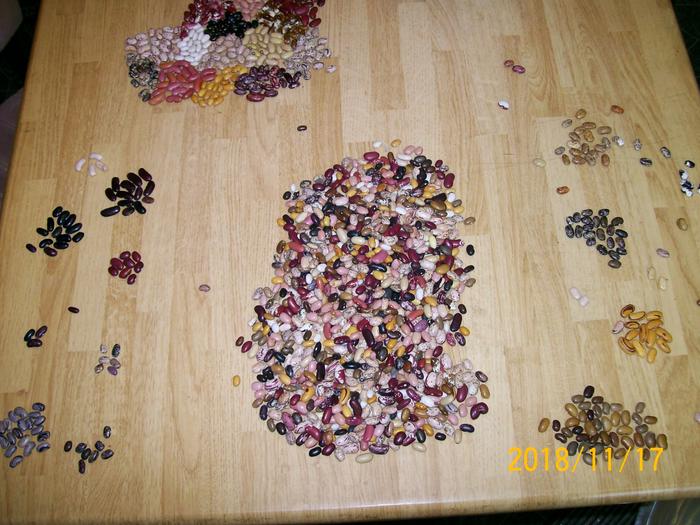

 3
3





 8
8





 3
3




Standing on the shoulders of giants. Giants with dirt under their nails
 2
2




Joseph Lofthouse wrote:
I took a few of the sunroots and made kraut-chi from them. Posted it for sale on our local social media. Utah recently passed a food freedom law, so it's legal for me to sell homemade food now.




Joseph Lofthouse wrote:
I do what I call "normalization" on the seeds that I'm saving for replanting next year, by saving equal numbers of every type that I can identify, and saving any seeds that are unusual or new.




Joseph Lofthouse wrote:Here are the same plums, shown 4 weeks ago in this thread.

 1
1








Joseph Lofthouse wrote:
I have not been selecting beans for flavor. How do I cook a pot of beans, when an individual plant might only produce 20 seeds? I suppose that I could grow and harvest by type, and get enough to cook a pot of beans.










 2
2




Mary Hysong wrote:I know you like Buttercup best also but I was wondering if you have a runner up that isn't like the others I listed? all of the above were terribly bland and some just tasted nasty to me.





 4
4





 5
5








Idle dreamer

 2
2




Tyler Ludens wrote:Will you be offering any Cucurbita moschata seeds?

 2
2




![Filename: rooster-silkie.jpg
Description: Bantum rooster, and the rooster that got it's face shredded. [Thumbnail for rooster-silkie.jpg]](/t/57161/a/69324/rooster-silkie.jpg)
![Filename: rooster-hanging.jpg
Description: Bleeding out [Thumbnail for rooster-hanging.jpg]](/t/57161/a/69325/rooster-hanging.jpg)
![Filename: chicken-dark-skin-meat.jpg
Description: Dark skin and meat [Thumbnail for chicken-dark-skin-meat.jpg]](/t/57161/a/69326/chicken-dark-skin-meat.jpg)





 1
1





 17
17





 5
5










 2
2





 1
1




![Filename: high-carotene-chickens.jpg
Description: Orange colored skin and fat due to eating high carotene corn. [Thumbnail for high-carotene-chickens.jpg]](/t/57161/a/71142/high-carotene-chickens.jpg)
![Filename: fat-soluble-carotenes.jpg
Description: Carotenes are fat soluble. [Thumbnail for fat-soluble-carotenes.jpg]](/t/57161/a/71143/fat-soluble-carotenes.jpg)
![Filename: chicken-testicles.jpg
Description: Testes. [Thumbnail for chicken-testicles.jpg]](/t/57161/a/71144/chicken-testicles.jpg)




I make a Maple Syrup instructional movie! Check it out HERE
SKIP books, get 'em while they're hot!!! Skills to Inherit Property
See me in a movie building a massive wood staircase:Low Tech Lab Movie

 2
2




Mike Jay wrote:How do you cook the testes? Are they any good?
 9
9




I make a Maple Syrup instructional movie! Check it out HERE
SKIP books, get 'em while they're hot!!! Skills to Inherit Property
See me in a movie building a massive wood staircase:Low Tech Lab Movie

 4
4




![Filename: high-carotene-chicken-fat.jpg
Description: Fat from rooster fed high carotene corn. [Thumbnail for high-carotene-chicken-fat.jpg]](/t/57161/a/71402/high-carotene-chicken-fat.jpg)
![Filename: seed-swap.jpg
Description: Seed swap [Thumbnail for seed-swap.jpg]](/t/57161/a/71403/seed-swap.jpg)




Western Montana gardener and botanist in zone 6a according to 2012 zone update.
Gardening on lakebed sediments with 7 inch silty clay loam topsoil, 7 inch clay accumulation layer underneath, have added sand in places.









 1
1




Western Montana gardener and botanist in zone 6a according to 2012 zone update.
Gardening on lakebed sediments with 7 inch silty clay loam topsoil, 7 inch clay accumulation layer underneath, have added sand in places.

 3
3




 1
1




Joseph Lofthouse wrote:
The Open Source Seed Initiative featured me in a podcast which was released today.
Season 2 Episode 2. Lofthouse-Oliverson Landrace Muskmelon -- Free The Seed! Podcast
Permaculture...picking the lock back to Eden since 1978.
Pics of my Forest Garden
 1
1




 3
3




stephen lowe wrote:Hey Joseph I got some of the true potato seeds from you but I'm not 100% sure how to go about planting them. Should I start them in a small container and transplant or do they do better direct seeded?
Western Montana gardener and botanist in zone 6a according to 2012 zone update.
Gardening on lakebed sediments with 7 inch silty clay loam topsoil, 7 inch clay accumulation layer underneath, have added sand in places.

 1
1




stephen lowe wrote:Hey Joseph I got some of the true potato seeds from you but I'm not 100% sure how to go about planting them. Should I start them in a small container and transplant or do they do better direct seeded?

 6
6




Landrace Gardening, author
Open Source Plant Breeding Forum, founder
Adaptation Agriculture: Video Course, Community, and Seed Share
Edited to add, that 2 days before I made this post that animal control captured a Mountain Lion about 2 miles from my apple orchard, which is at the wildland/suburban interface. Yikes!





![Filename: pruning-with-sawsall.jpg
Description: I love using a sawsall for pruning. [Thumbnail for pruning-with-sawsall.jpg]](/t/57161/a/75333/pruning-with-sawsall.jpg)
![Filename: joseph-lofthouse-orchard.jpg
Description: Pruning the orchard. [Thumbnail for joseph-lofthouse-orchard.jpg]](/t/57161/a/75334/joseph-lofthouse-orchard.jpg)

| I agree. Here's the link: http://stoves2.com |








